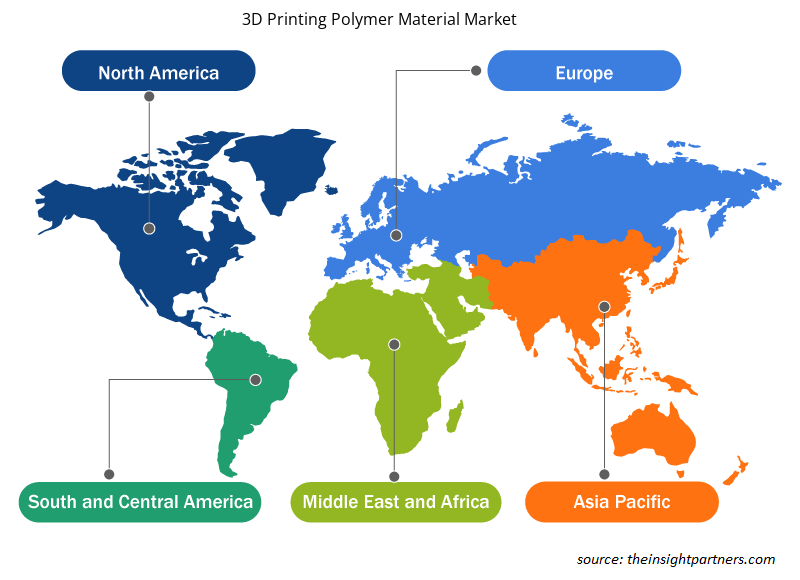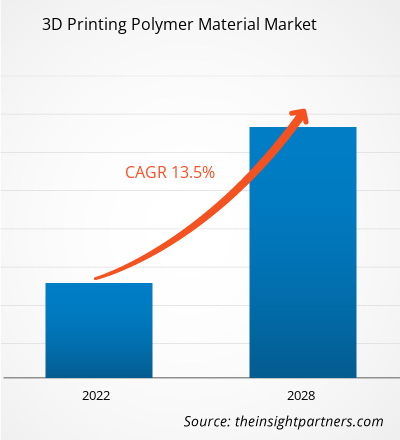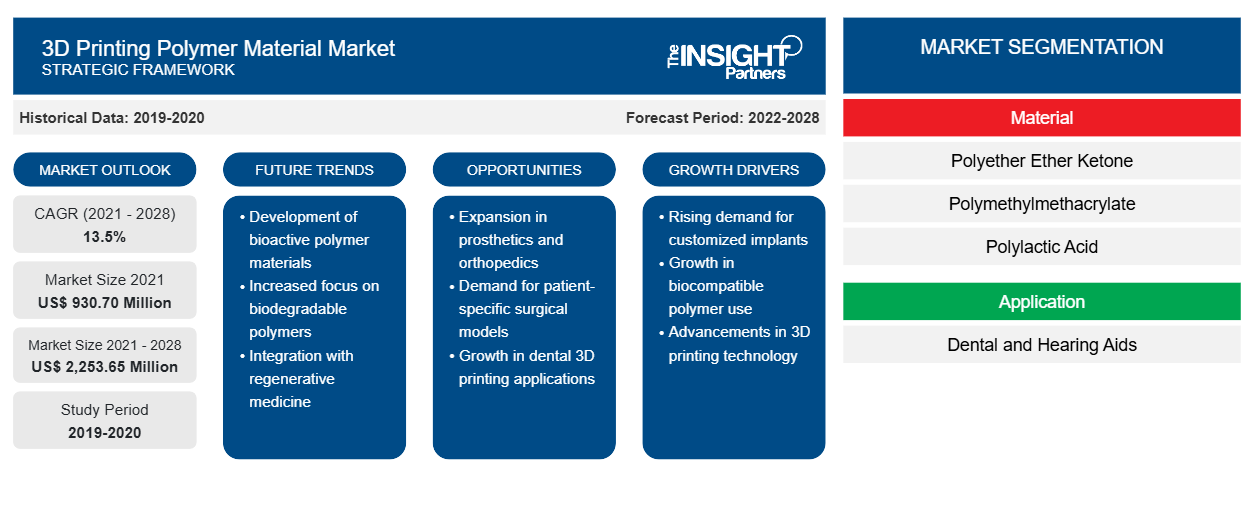Le marché des matériaux polymères d'impression 3D pour les applications médicales a été évalué à 930,70 millions USD en 2021 et devrait atteindre 2 253,65 millions USD d'ici 2028 ; il devrait croître à un TCAC de 13,5 % de 2021 à 2028.CAGR of 13.5% from 2021 to 2028.
Les polymères sont l'un des principaux matériaux d'impression 3D. L'impression 3D polymère est une technologie émergente qui a de plus grandes applications dans les industries, en particulier dans le domaine médical. Le matériau polymère d'impression 3D se compose de polyétheréthercétone, de polyméthacrylate de méthyle et d'acide polylactique. L'un des principaux moteurs de la croissance du marché des matériaux polymères d'impression 3D est l'utilisation croissante de l'impression 3D en dentisterie pour diverses applications. En dentisterie, l'utilisation de l'impression 3D a connu une augmentation rapide. La technologie d'impression 3D est très utilisée par les dentistes pour remplacer ou réparer une dent endommagée, créer un modèle orthodontique et produire des couronnes, des capuchons et des prothèses dentaires.
En 2020, l'Amérique du Nord détenait la plus grande part des revenus du marché mondial des matériaux polymères d'impression 3D pour les applications médicales . Le vieillissement croissant de la population et l'exposition croissante aux bruits forts en raison de l'urbanisation et de l'industrialisation rapides en Amérique du Nord entraînent une augmentation de la population sourde. Cela stimule la demande d'appareils auditifs et favorise par conséquent la croissance du marché nord-américain des matériaux polymères d'impression 3D pour les applications médicales. Selon l'enquête sur les revenus et la participation aux programmes (SIPP), plus de 600 000 personnes aux États-Unis sont sourdes et environ 28 millions de personnes du pays souffrent de surdité partielle. Par conséquent, la région connaît une demande d'appareils auditifs et offre des opportunités lucratives aux fabricants de matériaux polymères 3D pour accroître leur part de marché en Amérique du Nord.
Personnalisez ce rapport en fonction de vos besoins
Vous bénéficierez d'une personnalisation gratuite de n'importe quel rapport, y compris de certaines parties de ce rapport, d'une analyse au niveau des pays, d'un pack de données Excel, ainsi que de superbes offres et réductions pour les start-ups et les universités.
-
Obtenez les principales tendances clés du marché de ce rapport.Cet échantillon GRATUIT comprendra une analyse de données, allant des tendances du marché aux estimations et prévisions.
Impact de la pandémie de COVID-19 sur le marché des matériaux polymères d'impression 3D pour applications médicales
Avant la pandémie de COVID-19, le marché des matériaux polymères d'impression 3D pour les applications médicales était en croissance en raison de la forte demande de polymères dans l'impression 3D pour fabriquer différents dispositifs médicaux, instruments, implants personnalisés et modèles médicaux. Cependant, en 2020, diverses industries ont dû ralentir leurs opérations en raison des perturbations des chaînes de valeur causées par la fermeture des frontières nationales et internationales. La pandémie de COVID-19 a eu un impact négatif sur les économies et les industries de divers pays en raison des confinements, des interdictions de voyager et des fermetures d'entreprises. La demande de matériaux polymères d'impression 3D dans des applications telles que les implants dentaires, les prothèses dentaires, les accessoires d'implants, les prothèses auditives a diminué en raison de la faible demande pour ces produits. Cependant, la demande de polymères d'impression 3D a augmenté pendant la pandémie de COVID-19 pour la production de différents équipements de protection individuelle et dispositifs médicaux. L'impression 3D polymère s'est imposée comme une technologie viable pour produire des valves de ventilation, des lunettes de sécurité, des écrans faciaux de protection et des écouvillons de test pendant la pandémie.lockdowns, travel bans, and business shutdowns. The demand for 3D printing polymer materials in application such as dental implants, dental prosthetics, implant accessories, hearing aids has reduced due to low demand for these products. However, the demand for 3D printing polymers have increased during the COVID-19 pandemic for the production of different personal protective equipment and medical devices.
Perspectives du marché
Utilisation croissante de l'impression 3D en dentisterie
En dentisterie, l'utilisation de l'impression 3D a connu une augmentation rapide. L'impression 3D offre divers avantages par rapport aux techniques soustractives/de fraisage. Elle permet de produire facilement des géométries complexes et de réduire le gaspillage de matière, qui est généralement perdu lors du fraisage. L'impression 3D permet d'imprimer plusieurs appareils à la fois. La précision est également améliorée avec l'impression 3D. Les applications de la technologie d'impression 3D en dentisterie sont très variées. Les maladies bucco-dentaires constituent un fardeau sanitaire majeur pour différents pays du monde et affectent les personnes tout au long de leur vie. Selon le Global Burden of Disease 2017, la carie dentaire non traitée des dents permanentes est le problème de santé le plus courant. La prévalence des maladies bucco-dentaires continue d'augmenter avec l'urbanisation croissante et l'évolution des conditions de vie. Différents produits dentaires fabriqués à l'aide de la technologie d'impression 3D trouvent de nombreuses applications dans la restauration de la structure dentaire. Par conséquent, l'incidence élevée des caries dentaires et d'autres maladies dentaires conduit à une utilisation croissante des produits imprimés en 3D en dentisterie.subtractive/milling techniques. It allows the production of complex geometries with ease and reduces wastage of material, which is generally lost to milling. 3D printing allows for multiple appliances to be printed at once. Accuracy is also improved with 3D printing. Applications of
Informations sur les applications
En fonction des applications, le marché mondial des matériaux polymères d'impression 3D pour les applications médicales est segmenté en prothèses dentaires et auditives. Le segment dentaire détenait une part plus importante du marché des matériaux polymères d'impression 3D pour les applications médicales en 2020. La croissance du marché des matériaux polymères d'impression 3D pour les applications médicales pour ce segment peut être attribuée à la forte adoption des matériaux polymères pour la conception de structures d'échafaudages en raison de leurs propriétés biologiques et mécaniques améliorées, de leur facilité de traitement, de leur faible coût de production et de leurs propriétés de légèreté par rapport aux métaux et aux céramiques.
Evonik Industries AG ; STRATASYS LTD ; Formlabs ; Henkel AG & COMPANY, KGAA ; Arkema ; BASF SE ; Roboze ; Bionic Production GmbH ; Orion Additive Manufacturing GmbH ; et Solvay SA font partie des acteurs opérant sur le marché mondial des matériaux polymères d'impression 3D pour les applications médicales. Les acteurs du marché se concentrent sur la fourniture de produits de haute qualité pour répondre à la demande des clients.
Aperçu régional du marché des matériaux polymères pour l'impression 3D
Les tendances et facteurs régionaux influençant le marché des matériaux polymères d’impression 3D tout au long de la période de prévision ont été expliqués en détail par les analystes d’Insight Partners. Cette section traite également des segments et de la géographie du marché des matériaux polymères d’impression 3D en Amérique du Nord, en Europe, en Asie-Pacifique, au Moyen-Orient et en Afrique, ainsi qu’en Amérique du Sud et en Amérique centrale.

- Obtenez les données régionales spécifiques au marché des matériaux polymères d'impression 3D
Portée du rapport sur le marché des matériaux polymères pour l'impression 3D
| Attribut de rapport | Détails |
|---|---|
| Taille du marché en 2021 | 930,70 millions de dollars américains |
| Taille du marché d'ici 2028 | 2 253,65 millions de dollars américains |
| Taux de croissance annuel moyen mondial (2021-2028) | 13,5% |
| Données historiques | 2019-2020 |
| Période de prévision | 2022-2028 |
| Segments couverts |
Par matériau
|
| Régions et pays couverts |
Amérique du Nord
|
| Leaders du marché et profils d'entreprises clés |
|
Acteurs du marché des matériaux polymères pour l'impression 3D Densité : comprendre son impact sur la dynamique commerciale
Le marché des matériaux polymères d'impression 3D connaît une croissance rapide, tirée par la demande croissante des utilisateurs finaux en raison de facteurs tels que l'évolution des préférences des consommateurs, les avancées technologiques et une plus grande sensibilisation aux avantages du produit. À mesure que la demande augmente, les entreprises élargissent leurs offres, innovent pour répondre aux besoins des consommateurs et capitalisent sur les tendances émergentes, ce qui alimente davantage la croissance du marché.
La densité des acteurs du marché fait référence à la répartition des entreprises ou des sociétés opérant sur un marché ou un secteur particulier. Elle indique le nombre de concurrents (acteurs du marché) présents sur un marché donné par rapport à sa taille ou à sa valeur marchande totale.
Les principales entreprises opérant sur le marché des matériaux polymères d'impression 3D sont :
- Evonik Industries AG
- STRATASYS LTÉE
- Formlabs
- Henkel AG & COMPANY, KGAA
- Arkema
Avis de non-responsabilité : les sociétés répertoriées ci-dessus ne sont pas classées dans un ordre particulier.

- Obtenez un aperçu des principaux acteurs du marché des matériaux polymères d'impression 3D
Rapports en vedette
- Tendances industrielles progressistes sur le marché des matériaux polymères d'impression 3D pour applications médicales pour aider les acteurs à développer des stratégies efficaces à long terme
- Stratégies de croissance des entreprises adoptées par les marchés développés et en développement
- Analyse quantitative du marché des matériaux polymères d'impression 3D pour applications médicales de 2019 à 2028
- Estimation de la demande mondiale de matériaux polymères pour l'impression 3D
- Analyse des cinq forces de Porter pour illustrer l'efficacité des acheteurs et des fournisseurs opérant dans l'industrie
- Développements récents pour comprendre le scénario concurrentiel du marché
- Tendances et perspectives du marché ainsi que facteurs qui stimulent et freinent la croissance du marché des matériaux polymères d'impression 3D pour applications médicales
- Aide au processus de prise de décision en mettant en évidence les stratégies de marché qui sous-tendent l'intérêt commercial, conduisant à la croissance du marché
- La taille du marché des matériaux polymères d'impression 3D pour les applications médicales à différents niveaux
- Aperçu détaillé et segmentation du marché, ainsi que la dynamique de l'industrie des matériaux polymères d'impression 3D
- Taille du marché des matériaux polymères d'impression 3D pour applications médicales dans diverses régions avec des opportunités de croissance prometteuses
Marché des matériaux polymères d'impression 3D pour applications médicales
Matériel
- Polyéther éther cétone
- Polyméthacrylate de méthyle
- Acide polylactique
- Autres
Application
-
Dentaire
- Implants dentaires
- Prothèses dentaires
- Accessoires pour implants
- Autres
- Appareils auditifs
Profils d'entreprise
- Evonik Industries AG
- STRATASYS LTÉE
- Formlabs
- Henkel AG & COMPANY, KGAA
- Arkema
- BASF SE
- Roboze
- Bionic Production GmbH
- Orion Additive Manufacturing GmbH
- Solvay SA
- Analyse historique (2 ans), année de base, prévision (7 ans) avec TCAC
- Analyse PEST et SWOT
- Taille du marché Valeur / Volume - Mondial, Régional, Pays
- Industrie et paysage concurrentiel
- Ensemble de données Excel
Rapports récents
Rapports connexes
Témoignages
Raison d'acheter
- Prise de décision éclairée
- Compréhension de la dynamique du marché
- Analyse concurrentielle
- Connaissances clients
- Prévisions de marché
- Atténuation des risques
- Planification stratégique
- Justification des investissements
- Identification des marchés émergents
- Amélioration des stratégies marketing
- Amélioration de l'efficacité opérationnelle
- Alignement sur les tendances réglementaires























 Obtenez un échantillon gratuit pour - Marché des matériaux polymères pour l'impression 3D
Obtenez un échantillon gratuit pour - Marché des matériaux polymères pour l'impression 3D